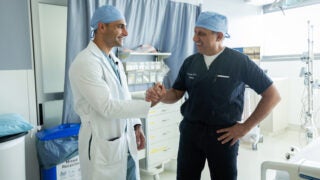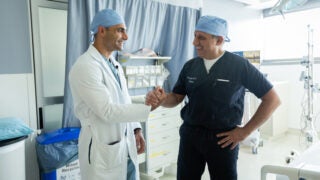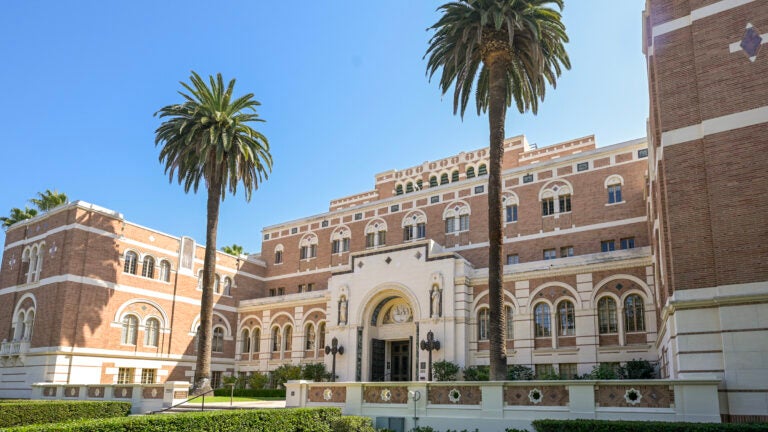
The Doheny Memorial Library’s Romanesque Revival building transports students back to 1932, the year the library opened. (USC Photo/Gus Ruelas)
An exciting chapter for the USC Libraries
With a new dean and innovative initiatives in the works, USC’s library system is abuzz with activity — from new collections to expanding connections.
The USC Libraries have had a landmark year in 2024 — you might even say it’s one for the “books.”
In February, USC officially welcomed the new dean of the USC Libraries, Melissa Just, at her installation ceremony. In August, the university joined the Big Ten Academic Alliance (BTAA), the athletic conference’s academic counterpart. This introduced reciprocal borrowing privileges between USC’s libraries and any university library in the Big Ten (as well as the University of Chicago, a BTAA affiliate).
Leavey Library and the USC Digital Library both turned 30 this year, marking three decades since the USC Libraries emerged as an international leader in innovative teaching, learning and research for the internet age. These milestones have come on the cusp of another new tech era: the rise of digital information culled and created by artificial intelligence.
It’s an exciting time for the USC Libraries’ faculty and staff, who continually balance preserving intellectual treasures of the present and past with integrating information technologies of the future.
“Libraries are living organisms,” says Ruth Wallach, associate dean of the social sciences and humanities libraries division, who has worked at the USC Libraries for more than 36 years. “They are not static. They grow, and they change.”
Here are some of the most notable collections, programs and initiatives being introduced at the USC Libraries to meet the opportunities and challenges of the moment.
Cultivating novel collections
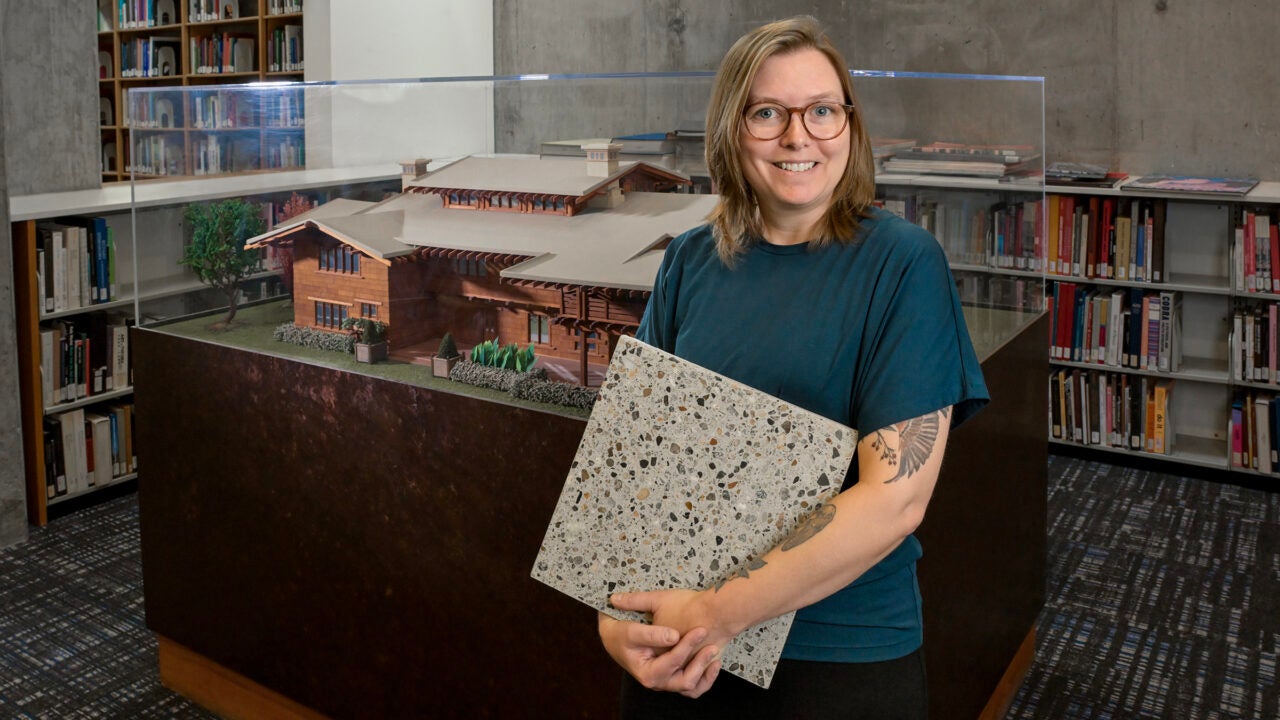
The collections at USC’s dynamic system of 19 libraries — 16 of them with physical locations across the University Park and Health Sciences campuses — demonstrate remarkable depth and breadth. Some of the most unique include the Regional History Collection in Special Collections at Doheny Memorial Library, which documents Southern California history; Hoose Library of Philosophy’s Gomperz Collection, a trove of illuminated medieval manuscripts and rare books by leading thinkers of the Enlightenment and Romanticism; the East Asian Library’s Korean Heritage Library collection; the extensive film memorabilia collection at the Cinematic Arts Library; and the collection of rare historical medical texts at the Norris Medical Library.
The USC Libraries’ newest collection is taking shape at one of USC’s oldest libraries: the Architecture and Fine Arts Library (AFA), which traces its inception to 1923 (though it’s now housed in a building erected in 1974).
Since last fall, AFA’s head librarian Shannon Marie Robinson has been collaborating with students to compile samples of sustainable materials for use in art, design and building projects. The growing collection features 25 different types of material samples donated from about 20 local and global creators — everything from low-carbon concrete masonry to 100% recycled plastic composite to terrazzo tile made of debris scooped from the Los Angeles River.
Each material is evaluated holistically — not just for its renewable or recyclable properties but also in terms of its cultural history, the carbon emissions created by shipping it, and the values and ethics of the companies creating it.
Robinson and the student researchers are developing a website to catalog the materials and contextualize them with research findings. The collection is also the beginning of a tactile “materials lab” where students and other library patrons can handle the samples in person.
“When handling samples, you use touch and your other senses,” Robinson says. “You have the feel, the weight, the smell, the color, the texture. Having all those senses enacted stimulates creativity. You start speculating and asking questions. Materiality is really a way to drive innovation.”
Robinson hopes that as students interact with the collection, they’ll be inspired to incorporate these nontraditional materials into their design projects or use them as a starting point for sustainable design ideas. She also envisions that the collection will expand to include student research and materials for use in engineering, health sciences and other disciplines.
For Just, the AFA materials lab represents a compelling new direction for the USC Libraries. Part of Just’s vision is to create more opportunities such as this to “draw people in and help them imagine how the collections are contributing to creating new knowledge … instead of just being on the shelf waiting for a person to discover them,” she says.
Nurturing interactivity
Just points out that USC’s archival collections also present opportunities for interactive research, teaching and learning.
“One of the things that USC Libraries does better than any place I’ve ever worked is activate our collections in really meaningful ways,” says Just, who started her career at USC’s Norris Medical Library and worked at the University of California, San Diego, Rutgers University, and the University of Saskatchewan and before returning to USC. “There’s so much programming that brings our unique collections to life.”
Two current exhibitions serve as excellent examples. Running through Nov. 23 is Sci-Fi, Magick, Queer L.A.: Sexual Science and the Imagi-Nation, a USC Fisher Museum of Art exhibition presented as part of the Getty’s PST ART: Art & Science Collide initiative. Featuring rare materials from private collections and the USC Libraries’ ONE Archives — the world’s largest LGBTQ-plus repository — the exhibition explores how science fiction, the occult and the LGBTQ-plus community intersected in 1930s-’60s Los Angeles.
Last week, the exhibition Spectral Science: Visions of the World Beyond opened at Doheny Memorial Library. It gathers photographs, rare books, magic lanterns and other artifacts to explore the complex interplay between science, illusion and popular belief in the supernatural during the Victorian era. The materials on display through May 31, 2025, in Doheny’s Treasure Room are drawn from the USC Libraries’ Special Collections as well as private collectors, the Academy of Magical Arts at the Magic Castle and the Society of American Magicians. USC’s arts and humanities initiative Visions & Voices is presenting programming to bring the exhibition to life.
Another type of interactivity happens at Leavey Library’s Ahmanson Lab — part of the USC Sidney Harman Academy for Polymathic Study — where students are learning to master new digital technologies for use in collaborative research projects that draw upon the USC Libraries’ collections. Melissa Miller, head librarian of the Hoose Library of Philosophy, leads the project, which is facilitated by the lab. Students use Scalar — an open-source authoring and publishing platform developed by USC researchers and supported by the USC Libraries; the USC Dornsife College of Letters, Arts and Sciences; and the USC School of Cinematic Arts — and advanced imaging techniques to digitally showcase and study medieval manuscripts in remarkable detail. These handwritten manuscripts decorated with precious metals such as gold and silver were acquired by the Hoose Library of Philosophy and are housed in Special Collections at Doheny Memorial Library.
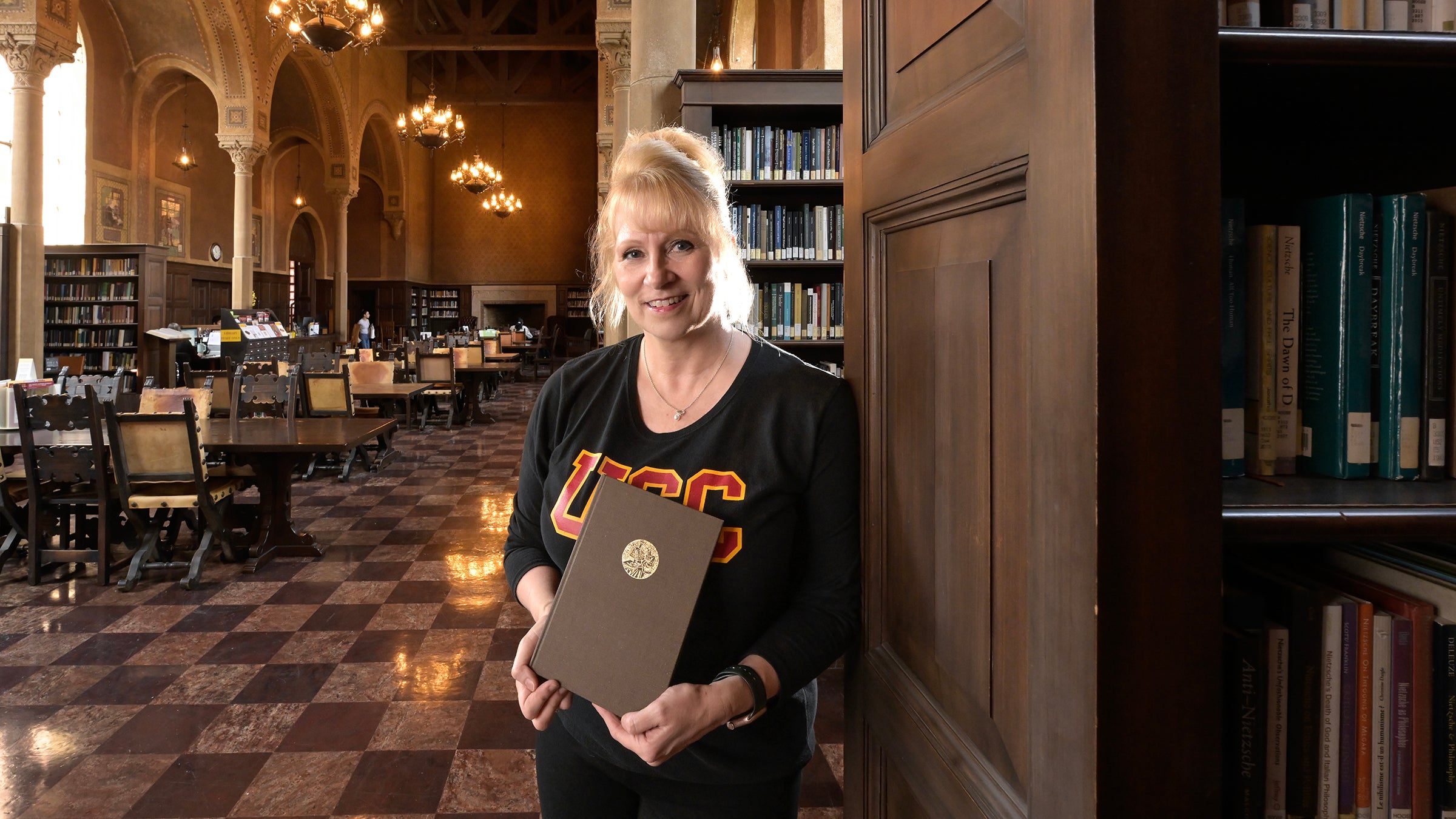
“The project enhances accessibility, making these resources available to a broader audience than ever before,” Miller says.
Another project at the Ahmanson Lab delves into more recent history. Students participating in the Bunker Hill Refrain project are researching archival maps and photographs and designing and fabricating a 3D, fully immersive reconstruction of Los Angeles’ Bunker Hill neighborhood from the late 1930s and early 1940s.
“It’s a really good example of our unique archives, in this case focusing on Southern California history, intersecting with the application of technologies … to help create new forms of knowledge delivery in partnership with other units on campus,” Just says.
At the USC Digital Repository, which is a part of the USC Libraries, AI technology is being used to create a novel collection of interactive video interviews with important figures. State-of-the-art machine learning technology transcribes users’ questions, matches the most relevant response and plays the corresponding prerecorded video answer. The first two interactive interviews in the collection — created in collaboration with Allissa V. Richardson, associate professor at the USC Annenberg School for Communication and Journalism — are with Lora King (the daughter of Rodney King) and Ilyasah Shabazz (daughter of civil rights icons Malcolm X and Betty Shabazz). They’re based on interviews conducted by Richardson’s Second Draft Project, a groundbreaking oral history series at the USC Charlotta Bass Journalism and Justice Lab that amplifies Black voices.
Reconceptualizing space
For many students, the spaces that the USC Libraries offer for studying and gathering are just as important as the books and artifacts they contain.
The Hoose Library of Philosophy in the Seeley W. Mudd Hall of Philosophy, built in 1929, is an iconic space that has inspired generations of Trojan scholars. It boasts soaring cathedral ceilings, Moorish arches, stained glass windows and refectory tables that look like something out of a Harry Potter film set. “Many people call it USC’s ‘Hogwarts,’” says Miller. “It has the feeling of what you think an academic research library should look like.”
Similarly, the Los Angeles Times Reference Room at Doheny Memorial Library — with its soaring blue-and-gold coffered ceiling and walnut tables beneath bronze and pewter chandeliers — transports students back to 1932, the year the library opened. “There’s something inspiring about spaces like that that visually connect you to what has come before,” Just says.
But even as these venerable spaces endure largely unchanged, Just sees opportunities to transform other library spaces that are in flux or underutilized across the USC Libraries’ large physical footprint.
“I think there’s huge potential for looking holistically across all of our spaces and ensuring that we are maximizing the delivery of services in those spaces,” she says.
In addition to adding more experiential spaces like the Ahmanson Lab and the AFA materials lab, Just envisions creating spaces designed to support student wellness. The designated campus “rest spot” at the Library for International & Public Affairs, added in coordination with the Undergraduate Student Government’s RestSC, is a model. Students can kick off their shoes and meditate or snooze in one of the soft “moon pods” behind dividers that separate the space from the rest of the library. Another rest spot is currently in the works at Leavey Library. Just would also like to establish a library space in which elements like lighting and acoustics specifically support neurodivergent learners.
“There’s enormous potential for library spaces to more deeply draw in, engage and support collaborative learning and creation for our entire campus community while also helping people find common ground with each other,” Just says.
Opening the digital door
While some staff at the USC Libraries are working to transform physical library spaces, others are working to expand online access to library resources in targeted ways.
As part of the BTAA Library Deans group, Just is collaborating with her peers across the Big Ten to build the infrastructure necessary to manage the distinct collections of BTAA member libraries as one unified library called the BIG Collection.
“The group coordinates efforts that bring together the separate and unique collections of each member institution to build a virtual single collection that’s available to all of our users at all campuses,” Just says. “It’s using the power of the collective to enrich access to resources that support the ambitions of our students and faculty.”
Taken together, the BIG Collection will represent roughly a quarter of all print titles in North America and be the third-largest library collection in the world, just behind the Library of Congress and the British Library.
Within USC, another group of library staff led by Melanee Vicedo — associate dean of teaching, learning and research engagement — is working to increase college affordability by spreading awareness of open educational resources. These free-use resources include e-textbooks that faculty can assign in their courses to offset students’ textbook costs. “We’re talking to many groups, including the bookstore, about these open educational resources and how we can promote them on campus,” Vicedo says.
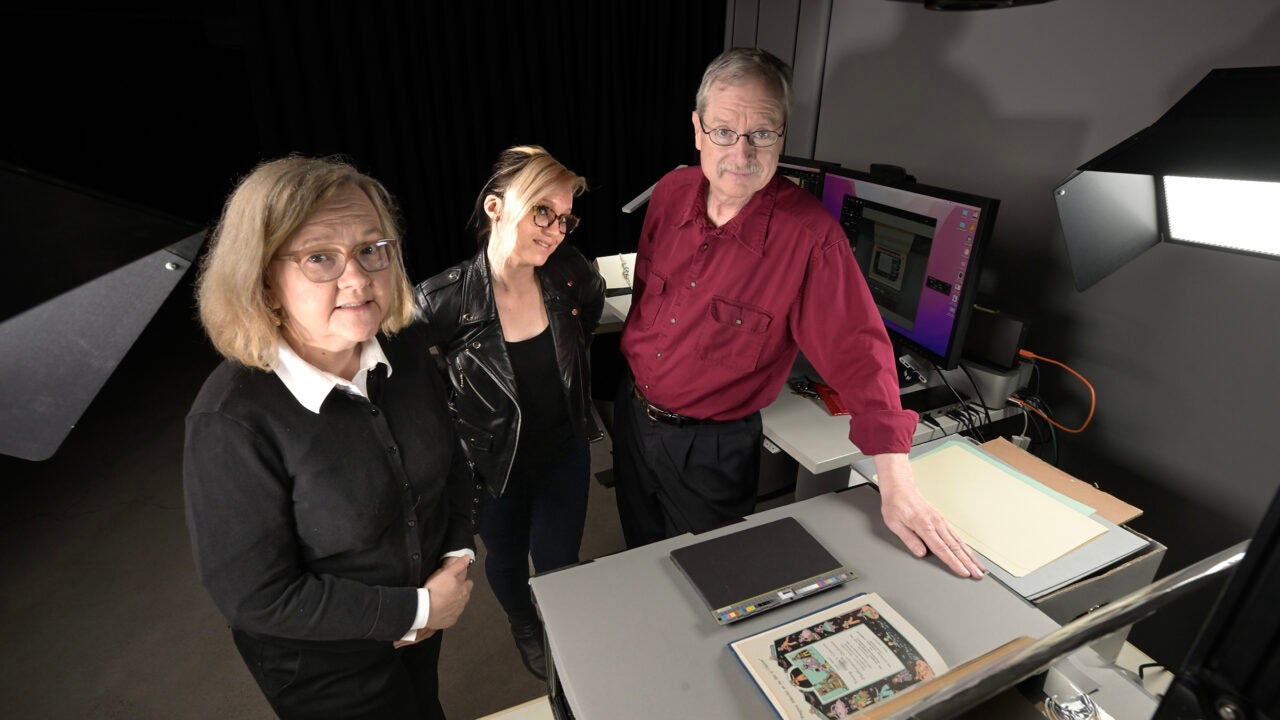
Deborah A. Holmes-Wong, director of the USC Digital Library, also leads a team that democratizes academic information. The Digital Library staff painstakingly digitizes rare and unique materials with the aim of “making these collections widely accessible to everyone,” she says — no USC affiliation necessary.
During the 30 years it’s been in existence, the Digital Library has grown to approximately 130 collections that encompass the subject strengths of the USC Libraries as a whole, representing the applied sciences, fine and decorative arts, history, performing arts and social sciences. Highlights include everything from past issues of the Daily Trojan to historic photos of Los Angeles to Dance Heritage videos.
“There’s a lot of hidden labor that goes into making these collections available,” Holmes-Wong says. For example, a single rare book can take more than a week to digitize. The team uses advanced technologies including camera-based capture and AI-driven color correction to create high-resolution digital images of each artifact.
It’s yet another example of how staff at the USC Libraries are embracing innovation in service of a timeless mission.
“Libraries house the historic record of humankind,” Just says. “Almost everything anyone does today builds on the knowledge that exists in the world from before.”


